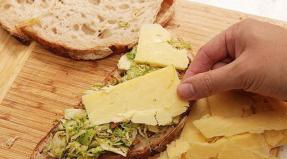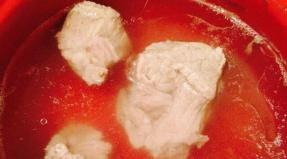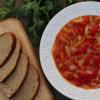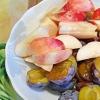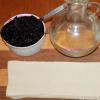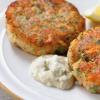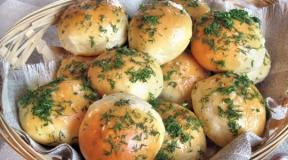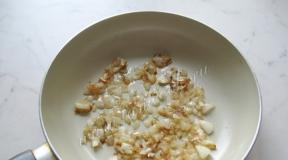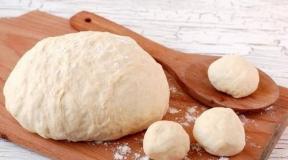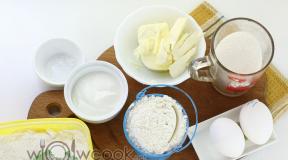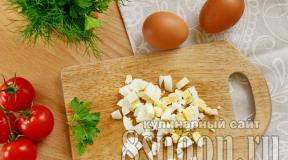Yeast production flow chart. Composition of baker's yeast according to GOST ...
Several types of yeast are used in the bakery industry. Yeast production involves the release of compressed yeast, yeast milk and dry yeast. In addition, yeast is produced in distilleries. Yeast is a single-celled microorganism that reproduces by budding and belongs to the class of fungi. For baker's yeast use the culture of Sacharomyces Cerevisie. Or more simply - saccharomycetes. One gram of compressed yeast contains approximately 15 billion yeast cells.
Yeast production is so difficult process that in the industry only specialists are engaged in them - microbiologists, who actually grow yeast. For example, yeast in distilleries is obtained from the remains of alcoholic yeast, however, this yeast is stored too little, since it is subject to severe clogging during the production process.
In addition to alcohol, yeast production also provides for the creation of yeast milk. Yeast milk is a semi-finished product, a kind of suspension in water, which is obtained at the stage of separation of the culture medium after growing yeast in it. Yeast milk is more active than compressed yeast.
Dry yeast is obtained in production by the technology of drying crushed compressed yeast, under certain conditions and at a certain humidity. Dry yeast can be stored longer and is easy to transport, but it is less active than compressed yeast. Therefore, they must be added to products in double quantities. The production of dry yeast provides for the release of premium and first grade products, in the form of granules, noodles or small grains.
12. TECHNOLOGY OF BAKERY YEAST
The yeast industry of the republic is represented by one of the oldest enterprises - OJSC Yeast Plant, which includes the Minsk Yeast Plant and the Oshmyany Yeast Plant. The main activity of the Yeast Plant OJSC is the production of baker's yeast (pressed and dry) using molasses. The capacity of the enterprise is 20,300 tons of yeast per year.
The term "baker's yeast" or simply "yeast" usually refers to microorganisms that belong to the class of lower fungi - Saccharomyces cerevisiae.
Yeast is used in bakery as causative agents of alcoholic fermentation and baking powder due to the released carbon dioxide. In addition, yeast contains glutathione, which affects the structure of glutenin by cleaving intramolecular disulfide bonds in it. Glutenin is the main protein wheat flour, the structure of which determines the structure and texture of the dough. As a result of microbiological processes and, first of all, alcoholic fermentation, compounds accumulate that have a significant effect on the taste and aroma of bread and to some extent increase its nutritional value.
In the vitamin industry, baker's yeast serves as a source of vitamins B and D; in the pharmaceutical industry, nucleic acids, enzymes, a number of drugs... Yeast is used in biotechnology for the preparation of nutrient media.
Saccharomyces cerevisiae are facultative anaerobes. In an environment devoid of oxygen, they reproduce poorly, but quickly ferment sugars to form ethanol and carbon dioxide with the release of a small amount of heat:
C6 H12 O6 = 2C2 H5 OH + 2CO2 + This process of alcoholic fermentation is the main one in
fermentation of dough in baking.
In the presence of oxygen, yeast assimilates carbohydrates with the release of large amounts of energy
С6 Н12 О6 + 6О2 = 6СО2 + 6Н2 О + The released energy is used by yeast for the synthesis of glu-
precise substance and maintenance metabolic processes, therefore, under conditions of aeration, an intensive accumulation of yeast biomass occurs.
zhey. A number of factors affect the rate of yeast reproduction and biomass yield: temperature, pH value, composition of the nutrient medium.
Saccharomyces cerevisiae are mesophiles with a temperature optimum of 29–30 C. At lower and higher temperatures, yeast activity slows down and the yield of the final product decreases. In addition, as the temperature rises, the likelihood of the development of foreign microorganisms in the nutrient medium increases, which deteriorates the quality of the product.
The optimum pH of the nutrient medium for yeast reproduction is 4.5–5.5. Under these conditions, the activity of enzyme systems is high, the processes of synthesis of proteins and vitamins, and a high growth rate of yeast cells proceed quickly.
The nutrient medium for growing yeast should contain easily digestible forms of carbohydrates (mono- and disaccharides), sources of nitrogen (soluble organic and inorganic nitrogen compounds), phosphorus, macro- and microelements, vitamins, growth stimulants.
The technological process for the production of baker's yeast is shown in Fig. 40 includes the operation of preparing a nutrient medium and accumulating inoculum, growing yeast, isolating it from the culture liquid and obtaining the final product (pressed or dry yeast).
Preparation of the culture medium
– dilution of molasses
- aseptation
- clarification
– fortification with nutrient salts
Receiving seed
– obtaining uterine yeast
– seed yeast production
Getting commercial yeast
Isolation of yeast
- separation
– vacuum filtration(pressing)
Forming and packaging | Drying and packaging |
|
Compressed yeast | Dry yeast |
Rice. 40. Technological scheme for the production of baker's yeast
Preparation of the culture medium. The main source of nutrients in the medium for growing yeast is the waste of beet sugar production - molasses. At the same time, in addition to substances useful for yeast, molasses also contains undesirable impurities: colloidal and suspended substances, which, being adsorbed on the surface of yeast cells, disrupt normal metabolism, and substances that inhibit the growth and reproduction of yeast. Therefore, the preparation of molasses is carried out, which includes the following operations:
– dilution of molasses with water (in a ratio from 1: 1 to 1: 3, depending on the composition of the molasses and the level of its contamination by microorganisms);
– aseptation of molasses in a cold or hot way. In the first case, bleach is added to the molasses and acidified with sulfuric acid to pH 4.5–5.0, in the second - boiled or sterilized in plate heat exchangers;
– removal of suspended particles by centrifugal force on separators-clarifiers;
– the addition of mineral salts and growth stimulants (ammonium sulfate, carbamide, ammonia water, diammonium phosphate, phosphoric acid, potassium, magnesium salts, corn extract, yeast autolysate or other sources of biotin - whey hydrolyzate, destiobiotin, etc.).
Getting seed. There are several technical
nological schemes for growing yeast, which differ in the number of stages, periodicity or continuity, the rate of dilution of molasses. The most common technological scheme, according to which the seed is obtained periodically in the form of uterine and seed yeast. Commercial yeast is obtained in two stages: first in batch conditions (enrichment culture), then in continuous.
In turn, a pure culture of uterine yeast is obtained
v several stages. In the laboratory, yeast is grown in test tubes, then in flasks under aseptic conditions (no foreign microorganisms) on fortified malt wort, only at the last stage adding molasses solution to the medium. Next, the yeast is propagated in the pure culture compartment sequentially in a small, large inoculator and a pure culture apparatus(ChK-1). Aseptic conditions are also maintained here, air is supplied for aeration.
spirit. The medium for the propagation of yeast is molasses wort, into which nutritious salts and growth stimulants are added. The process of obtaining a pure culture of uterine yeast (ChK-II) is coming to an end under production conditions in yeast-growing apparatus using the air-supply method. Air is supplied to the apparatus constantly, and the molasses solution is added as the yeast biomass accumulates. At all stages of obtaining uterine yeast, the temperature is maintained at 26-30 C, the pH value is 4.5-5.0, the duration of cultivation at each of the laboratory stages is 16-24 hours, at each stage in the pure culture department - 10-14 hours.
A pure culture of uterine yeast is obtained once every three to four weeks. For its better preservation, the yeast is separated, washed with cold water, concentrated to a concentration of 400-600 g / l and stored in refrigerated containers at a temperature not exceeding 6 C.
Inoculum yeast is obtained in two stages (ECHK-I and ECHK-II) according to the technological regime of natural pure culture, when strict aseptic conditions are not maintained, but the development of foreign microorganisms is largely prevented. This is ensured by the preparation of molasses (see above) and the treatment of uterine yeast, which is used for inoculation, with lactic or sulfuric acid. The first stage of cultivation is carried out in a periodic way, the second - in an air supply. Growing conditions (temperature, pH, duration) are the same as for obtaining uterine yeast. Yeast ECHK is prepared as needed, usually once a day and used for sowing when growing commercial yeast. They are isolated and stored in the same way as uterine yeast.
Getting commercial yeast. Growing commercial yeast
are in two stages. In the first yeast-growing apparatus, the process is carried out according to the air-supply method, the yeast ECHK-II is used as seed. For the second stage, yeast from the first apparatus is used as seed, cultivation here is carried out according to a continuous method, that is, the nutrient medium is constantly supplied and the culture liquid is taken into the selection apparatus. Cultivation at both stages is carried out at a temperature of 30 C and a pH value of 4.5–5.0.
In the selection apparatus, the yeast is ripened with aeration. Yeast cells use the remaining nutrients, complete the process of budding and growth, such cells retain their inherent properties for a long time.
Isolation of yeast. Ripe yeast must be isolated from the culture broth as soon as possible in order to avoid deterioration of its properties. Isolation of yeast is carried out in two stages: yeast milk is obtained by separation, then a pasty mass with a moisture content of 75% is obtained by filtration or pressing.
The best yeast quality is ensured with a three-stage separation. In this case, after the first and second stages of separation, the yeast concentrate is washed with cold water at a temperature of no more than 2 C to remove the remnants of the nutrient medium. After the third stage of separation, yeast milk with a concentration of 450-700 g / dm3 is finally cooled in a plate heat exchanger to a temperature of 4-8 C.
The final separation of yeast from yeast milk takes place on vacuum filters or filter presses. Vacuum filters have higher productivity, provide better sanitary conditions, and require less manual labor.
Forming and packaging of compressed yeast. Packaging-
filling machines give the pressed yeast mass the appearance of rectangular bars and wrap them in label paper. Packaged products are placed in boxes. Yeast is stored at a temperature of 1-4 C and a relative air humidity of 82-96%, shelf life - 12 days. Once frozen, yeast can remain active for a long time, however, when thawing and re-freezing, the yeast dies.
Drying yeast. Drying of yeast can significantly increase the shelf life of yeast (up to 6 months or more). Yeast should be directed for drying High Quality, without admixture of foreign microorganisms, osmo- and heat-resistant.
The faster the drying process, the higher the quality of the dried yeast. As the yeast must maintain its vitality and restore its vital functions under favorable conditions, high drying temperatures cannot be used.
Before drying, the yeast goes through a granulator, where it is shaped into vermicelli or granules. Dryers of different designs are used, more progressive is drying yeast in suspension with heated air. At the same time, the air temperature gradually decreases from 50 to 30 C in order to avoid overheating.
yeast, when intercellular moisture is removed and the slow removal of intracellular moisture begins. The final moisture content of the yeast is no more than 8% for top grade and no more than 10% for grade I yeast. Dried yeast is packed in cans or plastic bags and stored at a temperature not exceeding 15 C.

Our great-grandfathers used to say: "Bread is a Gift of God." But they did not bake it with thermophilic yeast. This yeast appeared before the war.
Scientists who were studying this issue came across sources from Hitler's Germany in the Lenin Library, where it was said that this yeast was grown on human bones, that if Russia does not die in the war, then it will die from yeast. Our specialists were not allowed to make links to sources, to copy them. The documents were classified.
So, if thermophilic yeast appeared recently, then with the help of what was kvass bread baked in ancient times and in the recent past? Famous peasant sourdough cultures were made from rye flour, straw, oats, barley, and wheat. Until now, in remote villages, recipes for making bread without today's yeast have been preserved. It was these starters that enriched the body with organic acids, vitamins, minerals, enzymes, fiber, pectin substances, biostimulants.
Baking bread in folk cuisine was a kind of ritual. The secret of its preparation has been passed down from generation to generation. Almost every family had their own recipe. Bread was prepared about once a week with various sourdoughs: rye, oat. Although the bread was rougher, the use of unrefined rye flour helped to preserve all nutrients which are found in cereals. And when baked in a Russian oven, bread acquired unforgettable taste and aroma. Such bread will not grow stale and moldy even after a year.
But for several decades now, bread has been baked differently. And for this they use not natural starters, but thermophilic yeast, Saccharomycetes, invented by man. The technology of their preparation is monstrous, anti-natural. Production baker's yeast based on their reproduction in liquid nutrient media. Molasses is diluted with water, treated with bleach, acidified with sulfuric acid, etc. Strange methods, admittedly, are used to prepare food, moreover, given that there are natural yeast in nature, hop yeast, for example, malt, etc. etc.
Scientists all over the world have sounded the alarm long ago. Mechanisms disclosed negative impact thermophilic yeast on the body. Let's see what thermophilic yeast-saccharomycetes is, and what role they play in the deterioration of the health of those who eat food prepared with their use.
Saccharomycete yeast (thermophilic yeast), the varieties of which are used in the alcohol industry, brewing and baking, do not occur in nature. Saccharomycetes, unfortunately, are more resistant than tissue cells. They are not destroyed either during cooking or by saliva in the human body. Yeast killer cells, killer cells kill sensitive, less protected cells of the body by releasing poisonous substances of low molecular weight in them.
The toxic protein acts on plasma membranes, increasing their permeability to pathogenic microorganisms and viruses. Yeast first enters the cells of the digestive tract, and then into the bloodstream. Thermophilic yeast multiplies in the body exponentially and allows the pathogenic microflora to actively live and multiply, inhibiting the normal microflora, due to which, with proper nutrition, both B vitamins and essential amino acids can be produced in the intestine. The activity of all digestive organs is grossly disrupted: stomach, pancreas, gallbladder, liver, intestines.
The inside of the stomach is covered with a special mucous membrane that is resistant to acid. However, if a person abuses yeast foods and acid-forming foods, then the stomach cannot resist this for a long time. The burn will lead to the formation of ulcers, pain and such a common symptom as heartburn.
The use of products prepared on the basis of thermophilic yeast in food promotes the formation of sand clots, and then stones in the gallbladder, liver, pancreas, the formation of constipation and tumors. In the intestines, putrefaction processes increase, pathogenic microflora develops, and the brush border is injured. The evacuation of toxic masses from the body slows down, gas pockets are formed, where fecal stones stagnate. Gradually, they grow into the mucous and submucous layers of the intestine. The secret of the digestive system loses its protective function and reduces the digestive function. Vitamins are insufficiently absorbed and synthesized, microelements are not properly absorbed, and the most important of them is calcium.
Another serious disease is acidosis, a violation of the acid-base balance. Fatigue, irritability increase, rapid physical and mental fatigue, nausea, bitterness in the mouth, gray plaque on the tongue, gastritis, black circles under the eyes, muscle pain from excess acid, loss of muscle elasticity appear. The body fights acidosis, spending a lot of energy to restore acid-base balance at the expense of itself, intensively wasting the most important alkaline reserve: calcium, magnesium, iron, potassium, sodium. The removal of alkaline mineral elements from the bones of the skeleton inevitably leads to their painful fragility, which is one of the main causes of osteoporosis at any age.
And finally, anatomical abnormalities. Normally, the heart and lungs and underlying organs - the stomach and liver, as well as the pancreas, receive a powerful massaging energetic stimulus from the diaphragm, which is the main respiratory muscle that soars up to the 4th and 5th intercostal spaces. During yeast fermentation, the diaphragm does not reach the required volume of oscillatory movements, it takes a forced position, the heart is horizontal, the lower lobes of the lungs are compressed, all the digestive organs are clamped by extremely swollen gases, deformed intestines. Often the gallbladder leaves its bed, even changing its shape. Normally, the diaphragm, making oscillatory movements, contributes to the creation of suction pressure in the chest, which attracts blood from the lower and upper extremities and the head for cleansing into the lungs. When her excursion is limited, the process does not proceed properly.
All this together contributes to the growth of stagnation in the lower extremities, small pelvis, head and ultimately leads to varicose veins veins, thrombus formation, trophic ulcers and to a further decrease in immunity.
The experience of the French scientist Etienne Wolff is noteworthy. For 37 months he cultivated the malignant tumor in a test tube with a solution containing the fermenting yeast extract. At the same time, for 16 months, an intestinal tumor was cultivated under the same conditions, without connection with living tissue. As a result of the experiment, it turned out that in such a solution, the size of the tumor doubled and tripled within one week. But as soon as the extract was removed from the solution, the tumor died. Hence, it was concluded that the yeast extract contains a substance that stimulates the growth of cancerous tumors (Izvestia newspaper).
This question cannot be passed over in silence. Where did the flour disappear from whole grain from which our ancestors baked bread? Only whole grain flour contains B vitamins, micro- and macroelements and the germ, which has fantastic medicinal properties... Refined flour is devoid of both the germ and the shell. Instead of these, naturally created, healing parts of grain, all kinds of nutritional supplements, chemically created substitutes that can never accomplish what nature itself created.
Refined flour becomes a mucus-forming product, which lumps down to the bottom of the stomach and slags our body. Refining is an expensive and costly process that kills the vitality of grain. And it is needed only in order to keep the flour from spoiling as long as possible. Whole flour cannot be stored for a long time, but this is not required. Let the grain be stored, and from it, as needed, you can prepare flour.
To restore the health of the nation, it is necessary to return to baking bread using yeast that exists in nature itself, in hops and malt. Bread on hop sourdough contains all essential amino acids, carbohydrates, fiber, vitamins Bl, B7, PP; minerals: salts of sodium, potassium, phosphorus, iron, calcium, as well as microelements: gold, cobalt, copper, which are involved in the formation of unique respiratory enzymes.
Apparently, it is no coincidence that the ears of grain are called golden. Bread based on hop sourdough gives the maximum sokogonny effect, that is, it actively extracts from the pancreas, liver, gallbladder enzymes and other substances necessary for full digestion, which improve intestinal motility. A person who uses such bread is filled with energy, stops hurting colds, his posture is straightened, immunity is restored.
Information about the dangers of eating bakery products made from baker's yeast slowly but surely enters the minds of people. Many people bake their own bread. Mini bakeries begin to open. This non-yeast bread is still expensive, but it disappears instantly. Needs outstrip supply.
In Ryazan, a bakery began to operate according to a new scheme; the same production is available in Noginsk. Everything new is well forgotten old ...
Alternative recipes
FRESH BREAD
1. Method of making unleavened cakes (lavash) at home. Ingredients: 1 glass of water, 2.5 glasses of flour, 1.5 teaspoons of salt (or to taste). Stir salt in water. Gradually pour flour in a thin stream into salt water... We knead the dough. Then let the dough stand (rest) for 20-30 minutes. Heat the pan. Roll out the cake thinly. Dry the cake for a few seconds in a hot frying pan. In total, 10-12 cakes are obtained. Ready-made cakes must be sprinkled with water (you can use a household spray), otherwise they will be crispy. It is better to store cakes in a plastic bag in the refrigerator for no more than 3 days.
2. Bread from sprouted grains of wheat. Wet, germinated wheat grains are pressed into flat cakes, then dried on open sun, you can on a hot stone.
3. Unleavened cakes and buns in mineral water. This is the most economical way, it is simple and accessible to everyone. Soda water can be made in a siphon, or you can buy any alkaline mineral water. Sift the calcined flour. Dilute mineral water... Form into tortillas or buns. Place them in a preheated oven.
4. Homemade yeast. Take 100-200 grams of raisins, wash warm water, placed in a bottle with a wide neck, poured with warm water, add a little sugar, tied on top with gauze in 4 layers and put in a warm place. On the 4-5th day, fermentation will begin, and you can put the dough. It should be fragrant and non-acidic.
5. Dry hop yeast. Pour hops hot water(1: 2) and boil in a saucepan. If the hop floats, it is drowned in water with a spoon. When the water evaporates so much that the broth remains half the original, it is decanted. In the cooled warm broth, dissolve sugar (1 tablespoon per 1 glass of broth), mix with flour (0.5 cups of flour per 1 glass of broth). Then the yeast is placed in a warm place for two days for fermentation. The finished yeast is bottled, sealed and stored in a cool place. To prepare 2-3 kg of bread, you need 0.5 cups of yeast.
6. Yeast from fresh hops. V enamel pot fresh hops are packed tightly, poured with hot water and boiled for about 1 hour, covered with a lid. Then the broth is cooled a little and salt, sakh is added. sand and 2 incomplete glasses of wheat flour. Knead the mass until smooth, put in heat for 36 hours, then rub a couple of peeled boiled potatoes, mix with yeast and let it ferment again in the warmth of the day. Ready yeast is poured into bottles and tightly closed with corks. The consumption of such yeast is a quarter of a glass per kilogram of flour.
7. Malt yeast. It doesn't hurt to remind you that malt is germinated in warmth and moisture grain of bread, dried and coarsely ground. 1 cup flour and 0.5 cups sugar. the sand is bred in 5 glasses of water, 3 glasses of malt are added and boiled for about 1 hour. Cool, pour the still warm solution into bottles, loosely cover with corks and put in a warm place for a day, and then in the cold. The consumption of this yeast for making bread is the same as for dry hop yeast.
One of the lucrative niches for small businesses is the production of various semi-finished products. These include and different kinds yeast. Yeast - widely used in winemaking, brewing, in the manufacture bakery products and even alcohol. Their production process is quite simple and profitable. This allows you to recoup your initial investment within a year.
Our business valuation:
Initial investment - 10,000,000 rubles.
Market saturation is medium.
Difficulty starting a business - 8/10.
Yeast types
At the moment all existing species yeast can be divided into 2 large categories: pressed and dry. The first ones contain about 70% moisture. This prevents them from being stored long time... For the same reason, their export is practically impossible. But on the other hand, most of the bakery shops are designed to work with them.
The second are dry granules, which must be dissolved in water before use. At the moment, for ease of use, a new type of dry yeast has been made - instant. There is no need to dissolve them in water before use. They are immediately added to the flour. All yeast produced in Russia must have a corresponding certificate of conformity.
Where to begin?
To open a yeast plant in Russia, you first need to find the necessary premises. Since this type of activity relates to food production, special attention should be paid to compliance with sanitary standards. This will be controlled by the relevant sanitary and epidemiological services. Therefore, at this stage, the easiest way is to rent a ready-made room intended for the production of food products.
In addition to sanitation, attention needs to be paid to the specifics of production. For example, the technology for making yeast requires adherence to a certain temperature regime. Therefore, the heat insulation of the workshop must be performed at the proper level. At the same time, do not forget about air conditioning systems. Raising the temperature above + 40 ° will negatively affect the quality of the yeast.
If we distribute production by area, it will look like this:
- Production line 280 m 2;
- Premises for a pumping station not less than 48 m 2;
- Power shop 48 m 2.
After preparation industrial premises you need to calculate the required number of personnel. For a small production, producing about 500 kg of products per day, 45-50 workers will need to be hired. Most of them, about 30-35 people, will be ordinary workers.
Equipment
Commercial yeast production involves the use of the following equipment:
- Yeast. Or, in another way, containers for planting yeast grown in the laboratory. Their number depends on the volume of production.
- Inoculator or, in a simple way, a vat for seeding. It grows yeast.
- Skimmer. Its main purpose is to separate the foam formed during fermentation.
- Transfer pumps.
- Separators. With the help of them, the separation of yeast from the mash is carried out.
- Washing tank.
- Plasmolysis.
- Dryer.
- Packing line.

All of the above yeast making equipment can be used to make pressed, dry or baker's yeast.
Production technology
The production of baker's yeast is carried out using the same technology. The differences are only in the methods of their final processing. The technological scheme of their production consists of 3 main stages:
- Growing up. This stage is subdivided into 2 main processes. During the first, the uterine culture is grown. During the second time, commercial yeast is grown.
- Isolation from the brew. First, the flotation process takes place, that is, the yeast culture is removed from the mash. Then it is thickened in separators.
- Dehydration. At this stage, the yeast is plasmolyzed and finally dried.
In general, the production of compressed yeast is about creating favorable conditions for the growth of the yeast fungus. By favorable conditions is meant a controlled nutrient medium consisting of easily digestible sugars. The main raw material for the production of yeast is molasses and mash based on it. In the process of growing yeast assimilate amino acids from them.
As they develop, they will absorb nutrients from it, so food has to be periodically added, and the mass itself will be enriched with oxygen. After reaching a certain volume, the growth of the mass is stopped forcibly. Next, the yeast is separated from the nutrient medium, that is, it is separated. The final final stage in the manufacturing process is the formation of the finished product.

 Traditionally, production of nutritional yeast in Russia is carried out by pressing. Pressed yeast briquettes are yeast cells isolated from the nutrient medium that have undergone special purification. They contain 68% water and 32% yeast cells.
Traditionally, production of nutritional yeast in Russia is carried out by pressing. Pressed yeast briquettes are yeast cells isolated from the nutrient medium that have undergone special purification. They contain 68% water and 32% yeast cells.
Dry yeast is made in a similar manner. With one exception, other yeast strains with increased resistance to drying are used in the production process. During drying, the compressed yeast is passed through an extruder. It forms a kind of "vermicelli" from them, which is then cut into granules. The pellets themselves are then sent to the dryer, where they are converted into dry pelletized yeast under the influence of warm air.
The production of feed yeast is carried out in a similar manner, with one exception. The yeast strains used do not require sterile conditions. Their feature is also that they give a higher biomass yield. The production of alcoholic yeast also has its own characteristics. Wort from malt is used as a nutrient medium for them.
Perspectives
According to statistics, the yeast business is developing quite dynamically. On average, sales of such enterprises grow by 5-7 percent per year. This is due to the constantly growing sales market.
Most of the imported analogs of dry yeast imported into the territory of Russia have risen in price due to high customs duties, which made them uncompetitive in comparison with the products of domestic producers. Therefore, the yeast business has a future.
Success secrets
The secret of the success of yeast production, like any other type of business, lies in the quality of the products. Also for large consumers the stability of supply is very important. To reach the required level, technology needs to be constantly improved by introducing new ideas into it.
It is also necessary to have a team of highly professional technologists on staff who will closely control the production process and monitor the quality of products.
Yeast is a living organism that has long been cultivated by humans and used to prepare food and drink. If you ask what yeast is made of, then it will be impossible to answer in one word. The fact is that they existed on earth even before the birth of human civilization.
Unique microorganisms
Yeast is a living microorganism that can feed and reproduce. They are very sensitive to changes in temperature and food composition.
Yeast mushrooms exist in nature everywhere. They feed on biological raw materials, and in the process of metabolism, that is, fermentation, they produce new chemical compounds. The number of these microorganisms in nature is so great that if we compare it with the number of grains of sand in the seas and on land, then yeast spores will be many times greater. Needless to say, there are also a great many varieties of yeast fungi. Some are good for our health, while others are harmful. All live yeast intensely emit carbon dioxide and alcohol fractions.
Types of mycetes used in the production of bread dough
In the food industry, and in our case in the baking industry, only some species are used, namely those that, eating a nutritious substrate, release a large number of carbon dioxide. It is thanks to the bubbles of this gas that the bread turns out to be porous. Its quality is even determined by how the loaf behaves, if you squeeze it until the opposite sides join and release it. If it straightens to its original state, it means that the bread is of high quality.

Yeast of this class also a lot. In the modern bakery industry, mushrooms from the Saccharomycete family are most often used for making soft bread.
Baker's yeast and leaven
What yeast is made of for baking bread, every baker knows. Talk about bread yeast the best place to start is with a story about the leaven. It is mentioned in ancient books dating back several millennia. Sourdough and baker's yeast are one and the same thing. Bread leaven is a product that has always been treated with special care. All actions with her were surrounded by many signs and rituals. The products from which the initial sourdough was made were chosen with great care. The most successful was kept and cultivated, passed down from generation to generation.
Quality bread is a guarantee of good health
The fact is that different types fungi exist under various conditions. And even if the dough made from yeast bred on the same raw material turns out to be very tasty, this does not mean that this leaven will show itself in the same way the next time it is used. There is always the possibility that the original mushroom culture has been replaced by a new one. This is not visible to the naked eye, but the next batch of bread may turn out to be tasteless and even unhealthy. It is no coincidence that in ancient times one of the ways to destroy an enemy tribe or other community was this. The scout penetrated the enemy's camp and spoiled the leaven, since it was believed that bread and water were the most important food for a person. Health and life depend on the quality of these two products. What does yeast do to the product? They change its appearance, consistency, composition and properties. To understand the mechanism of their work, you need to figure out how and from what baker's yeast is made.

Hop sourdough
Take one glass of hop cones, cover with two glasses of water and put on fire. Simmer until the liquid is halved. Cool to 37-40 degrees and strain. Put one to two tablespoons of sugar and half a glass of flour in the hop broth. Cover with cheesecloth. This is necessary in order for the yeast to receive oxygen, otherwise they will die. Place the container in a dry warm place away from direct sunlight and drafts. In two days, you will have a culture of baker's yeast, the very sourdough that, by taking a little, can be reused in baking. Typically, 1 kg of flour requires 50 to 100 g of sourdough.
Unusually tasty bread is made from barley malt sourdough with honey and hops. Malt is flour milled from sprouted and dried grains. Its microbiological composition is fundamentally different from the composition of flour made from polished grain.
The secret to delicious beer - malt, hops and yeast
Hops and barley malt is what brewer's yeast is made of. The brewing process is extremely simple. Whole grain of barley is soaked for germination. Rye grains are also what beer yeast is made from. However, due to its specific taste, barley is more commonly used. It is imperative to germinate. Yeast does not like unsprouted grain - it contains a lot of starch and little sugar. When the embryo is activated, that is, germination, the amino acid present in it, amylase, is activated in the grain. Amylase also hydrolyzes starch into mushroom-digestible sugar. The sprouted grain, called malt, is allowed to rest for a while to ensure the most complete fermentation, then ground, mixed with water and boiled with the addition of hop cones. The result is wort - an excellent feed for brewer's yeast.

Two types of yeast are used for beer. Some ferment the drink on the surface and live at a temperature of + 14-25 degrees Celsius. This so-called top yeast forms a frothy head on the surface of the wort. At the end of the process, the mass fermented with horse yeast sinks to the bottom. There, another colony begins to work - grassroots yeast. They work in colder conditions - at temperatures from +6 to +10 degrees.
The difficult art of the baker
In the old days, before the advent of electric ovens and refrigerators, the process of making bread and preserving the leaven was almost a mystery. The sourdough was not lent, and when they made bread (this process took at least two days), they tried not to make noise, not to slam doors and dampers. We watched the dough in order to have time to knead it in time and not let it sour. Failure to comply with the prescribed conditions is fraught with the development of another yeast culture, since different yeasts require different temperatures, density and composition of the nutrient substrate. Good yeast can be replaced by bad yeast. It was believed that a bad person's bread is always tasteless. They tried to buy bread only from a certain master.
Yeast is a source of vitamins essential for health
Yeast ferments the bread base in such a way that it changes in chemical composition. Good bread consists only of flour, water and sourdough, in which there is a small amount of sugar for a pleasant taste of bread - a consequence of the fermentation of flour with yeast. Yeast enriches bread with B vitamins and vitamin D. When baked in a Russian oven, most of the nutrients were retained. It is unclear if this was known in the olden days, but the oven temperature had three characteristics - before, after and during baking. The mild, even heat during the preparation of the bread was below the boiling point of water. In very high temperatures, the product burns on the outside and does not bake on the inside.

Modern dry yeast, unlike sourdough, is very convenient, as it is less capricious and more stable. Even an inexperienced housewife can bake excellent bread from them. In this regard, a natural question arises: "And what is dry yeast made of?"
Sugar, water, air and a temperature of 30-50 degrees - the optimal environment for saccharomycetes
Since yeast is living organisms, by and large they are not made, but grown from the usual yeast fungi used in the manufacture of bread - saccharomycetes, that is, bacteria that feed on sweet things - sugar, sucrose, fructose, etc. for baking yeast feed, beet waste is used - molasses. Sugar beet is what they are made of raw yeast at domestic enterprises.
Molasses
Yeast grows very quickly on this product. Molasses, also called black molasses, is a thick viscous liquid very dark in color. One ton of substrate grows up to 750 kg of yeast. Molasses from beets or sugarcane is what the pressed and instant baker's yeast is made of. Currently, with large production volumes and high demand for ready-made yeast, these are the most common bases for growing saccharomycetes. However, these mushrooms can grow well on other mushrooms rich in natural sugars. If you use a starchy substrate - potatoes or grain, then it should be fermented.

The safety of a modern proving product
Thus, it is obvious that what is used to make baker's yeast in modern production does not pose any harm to health. With proper storage and use, modern dry fast acting yeast there is no need to be afraid that new crops that are harmful to health will develop in them, because in food production use only those yeasts that have been well studied for resistance to various transformations. Moreover, they are significantly safer than home-made "wet" sourdough. In dry yeast, metabolic processes are in a static state. Metabolism begins only with the addition of sugar and liquid - water or milk.
Having figured out what yeast is made of for baking bread, you have to decide which one to give preference - raw pressed or dry instant (instant).
Pressed
The yeast mass grown on molasses is separated, that is, it is strained. Water is added to the yeast and separated again. As a result of several procedures, the yeast mass acquires a grayish color and viscous consistency... The vacuum apparatus removes excess moisture. This process is called sublimation. The resulting gray, plastic, clay-like substance is cooled, divided into portions, formed into briquettes, packed into and sold. Store such a product in the refrigerator at a temperature of minus 2 degrees Celsius and humidity environment about 72-75%. The shelf life is 12 days. In the retail sale of such yeast nowadays you can not always find. In this case, I would like to know what they are made of if they are such a rare product. After all, we very often tend to think that the products that adorned store shelves 20 years ago were much better than the current ones. It is possible that this is so, but not with regard to yeast.

It turns out that the point is not what the pressed bakery yeast is made of, but that it is extremely inconvenient to use. It is extremely difficult to withstand the required humidity and temperature in the dry cold conditions of a modern household refrigerator. The 12-day period also limits the housewife. Yeast dough is usually baked on weekends. A whole pack of compressed yeast is too much for one time. For a family of 4, even with invited guests, half a pack is more than enough, and it is impossible to keep such yeast active until next weekend.
Dry
They have long and firmly taken a place in our kitchens. I must say that, despite the modern electronic technologies that are used by manufacturers of this product, dry yeast has been known since pre-Christian times, when the leaven was dried in order to preserve it during long distance transportation. What dry yeast is made of is no different from what pressed yeast is made of. This is the same sweet syrup and, in fact, the saccharomycetes themselves.

The process of their production is longer, because the grown and partially dehydrated yeast mass should be dried and turned into granules. There are three types of dry yeast. These are dry active yeast, dry active instant and dry active instant instant. Sugar syrup and saccharomycetes are what they make fast yeast... Only the dewatering technology is different. If for ordinary dry yeast low-temperature drying is used according to the Russian stove technology, then the instant ones are dried in vacuum by sublimation. With the first method of drying, a product with a rather weak vital activity is obtained. Despite the fact that the life of such yeast is 12 months, they barely reach its end, so significantly losing the property of fermenting baked goods that it is advisable to buy them only at the beginning of the expiration date stated on the package. Therefore, when reading the accompanying inscription on the packaging, carefully study not only the information about what the baker's yeast is made of, the composition of the product, its calorie content, the name of the manufacturer, but also the date of manufacture of the yeast and its validity period.
Emulsifiers and Antioxidants
If you are against adding emulsifiers and antioxidants to the product, then use compressed yeast or starter culture. However, do not forget that in them the presence of microflora and chemical elements unhealthy for health is possible. Emulsifiers are added to the raw yeast mass before drying. All the thick mass is poured onto a pallet in a vacuum chamber. A vibration is created there, it separates the dried substrate into small fractions, which are then packaged into an Emulsifier and an antioxidant is added to the yeast to prevent unwanted growth of fungi and prevent them from sticking together before they are used in the dough. Do not think that these additives are included in the composition in order to harm our health. This opinion is deeply mistaken and very strongly smacks of amateurism and “yard competence” in matters of molecular chemistry. Sometimes you can even hear this: “Everyone knows perfectly well what yeast is made of. Compound good yeast- these are just saccharomycetes and nothing else! " However, even compressed yeast is poured vegetable oil so that they do not begin to actively multiply before they enter the sweet solution. After asking what dry yeast is made of (the composition is described on the package), you can see that the product contains natural yeast, emulsifier E 491, antioxidant E 320, starch or rehydrating agent. Those cases where only yeast is included in dry yeast and nothing else, they only say that the manufacturer did not indicate full information about the composition of their product, and by no means about the absence of stabilizing and disinfecting impurities. People with a sense of humor say that fear of food can kill much faster than food itself. This also applies to food additives.

Making bread from dough mixed with instant instant yeast is a pleasure. Very well proven instant yeast"Saf-moment". Knowing what the Saf-Moment yeast is made of, and this is indicated on the label, you have much more confidence in the manufacturer than if he had not written that a rehydrating agent was introduced into the yeast mass to control the moisture level. This yeast need not be diluted in sweet milk or sugar syrup. They will perfectly raise the dough if you pour them directly into flour or knead into the finished dough.
Ode to Saccharomyces and Vacuum
What to prefer - yeast or sourdough, everyone decides for himself. However, we figured out what yeast is made of. It is very difficult, or rather impossible, to grow not saccharomycetes on sugar molasses, but any mushrooms dangerous to health. Alcohol and carbon dioxide released by these little workers destroy the pathogenic microflora, and vacuum sublimation and sealed packaging ensure the absence of unsanitary impurities. Sourdough is a good thing, but is it possible to make it as sterile?
